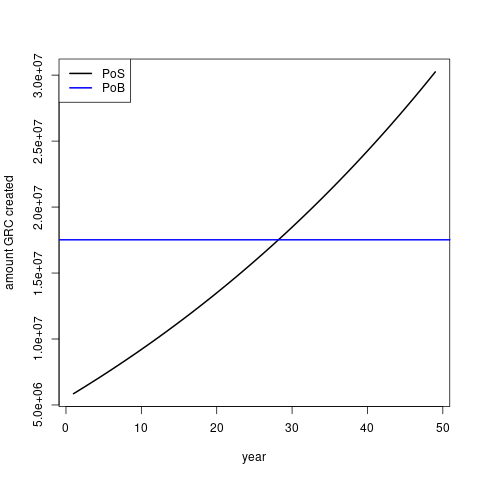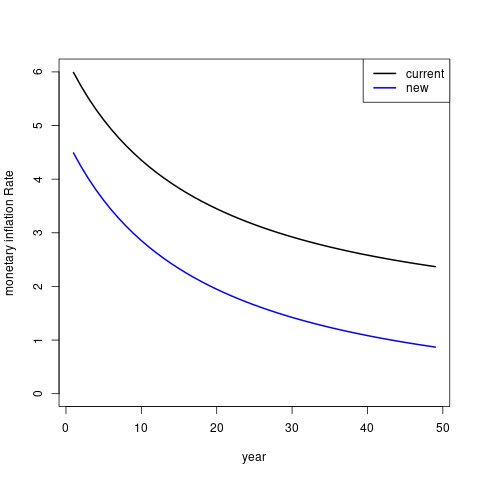Gridcoin reward mechanism and how to improve it
I am not going to introduce Gridcoin. So if you don't know what it is, this article is probably not for you and you should visit https://gridcoin.us/ to inform yourself.
Currently Gridcoin rewards its users in two ways. The first one is inherited from the pure PoS system Gridcoin is build upon. Every user who is staking a block is rewarded for it by generating a certain amount of new gridcoins. This amount is determined in a way that the yearly monetary inflation of the coins used for staking is approximately 1.5%.
The second way of earning rewards is through the contribution of computational resources to specific BOINC projects (PoB). This mechanism creates approximately 48000 GRC each day. That corresponds to a block reward of 50 GRC on average.
Implications for the Gridcoin network
For the following calculations it is assumed that every coin ever created is staking wich is obviously not true. But there is no reliable mechanism to figure out how many coins are used for staking. It is also not taken into account that there is compound interest throughout the year.
The current coin supply is 390,287,782 GRC and one can easily calculate the current yearly monetary inflation:
approx. monetary inflation through PoS: 0.015 x coin supply = 5,854,316.73 GRC
yearly paid PoB reward: 365 x 48000 GRC = 17,520,000 GRC
That leads approximately to a total monetary inflation rate of:
(5,854,316.73 GRC + 17,520,000 GRC)/390,287,782 GRC x 100 = 5.98%
So that looks all good, right? The amount of GRC generated via PoB is much higher than the coins created via PoS to ensure there is incentive to contribute to scientific computations. There is also an interest rate of 1.5% as an incentive for inverstors.
Ok then, lets take a look. My first claim that more GRC are generated by people contributing to scientific calculations might not be true.

In the plot you can see the amount of GRC being created each year over the next 50 years by PoS and PoB.
As you can see the amount of coins being created via PoB is constant while the amount of coins being created via PoS is increasing. In about 30 years potentially more coins are created by PoS instead of PoB. Ok, to be fair 30 years is a long time but if Gridcoin wants to be succesful it should work as intended for any amount of time.
Then what about the incentive to invest in Gridcoin? Right now the yearly monetary inflation rate lies somewhere between 4.48% (only taking PoB into account) and 5.98%. With a yearly interest rate of 1.5% your share of the total money supply will still decrease. So from an investor point of view the most important thing is an increasing userbase and market interest in the coin.
How to make things better?
First of all Gridcoin needs inflation. If there was a fixed coin supply like bitcoin offers it would be very difficult to keep up the incentive to do BOINC computations. But maybe the inflation can be lower and tending towards 0% instead of 1.5%. That could be achieved with a fixed block reward. Instead of getting a yearly reward of 1.5% for staking you would get a fixed amount of GRC for each block you stake. That would also increase the incentive to stake all the time instead of collecting your rewards only once in a while. And it would solve the problem with the amount of GRC being created by PoS vs PoB.
Additionally Gridcoin could adopt something like the budget system in DASH and some other cryptocurrencies. The idea is that a fraction of the block reward is not given to the account that staked the block but is credited to an address that is owned by the network itself. These funds could then be used to finance further development and promotion of gridcoin, very much like the foundation funds gridcoin already has left over from the transition to Gridcoin Research. It would generate a constant income to secure the funding of future projects.
Additionally part of these funds could be used to support science. Each whitelisted project could be rewarded with gridcoins. The project leaders could then decide what they want to do with these funds. (rain over the participants, reduce server costs, buy new hardware etc.)
How could a new reward system actually look like?
Lets set the average total block reward to 50 GRC (or 48000 GRC per day). It is the same number of gridcoins currently being generated by PoB only. So with that the current monetary inflation rate would drop to 4.48% and would slowly decrease.
The following table shows a possible distribution of the total rewards over PoS, PoB and the foundation budget.
| / | PoS reward | PoB reward | decentralized foundation budget | total |
|---|---|---|---|---|
| share | 20% | 60% | 20% | 100% |
| average block reward | 10 GRC | 30 GRC | 10 GRC | 50 GRC |
| yearly rewards | 3,504,000 GRC | 10,512,000 GRC | 3,504,000 GRC | 17,520,000 GRC |
In the following plot you can see the approximated inflation rate over the next 50 years for the current reward system and the proposed new reward system.

As you can see the monetary inflation would be lower than it is with the current reward system. It would tend towards 0% but never actually reach it. In 20 years the monetary inflation would still be at 2% per year. And that is not taking lost coins or burned coins into account.
Conclusion
With a new reward system Gridcoin could not only secure funding for future development and projects, it could also help scientific projects with rewards/donations through the decentralized foundation. Helping and funding BOINC projects is in the own interest of Gridcoin. With great BOINC projects the interest in Gridcoin will also increase. This will hopefully lead to a self-sustaining decentralised network. Investors and BOINC contributors will profit from this. And last but not least investors will recognize the lower monetary inflation.
Great post. I too have considered the inflation problem but was too lazy to write it down. We dont want staking to overtake BOINCing in terms of profitability. Other options for PoS could be to gradually wind back the interest rate from 1.5% on a pre-defined schedule (based on total coin circulation?), this would help prevent big investors from getting spooked.
I did not know that PoB rewards were fixed and I agree about setting a new algorithm that reduces PoS rewards over time. You should open a thread in Gridcoin forum to notice more people about your proposition and know what other users think about it. In my opinion PoB rewards should be 70-75%
POB rewards are not fixed, however there is a maximum amount per day that can be created.
What are your thoughts about:
Maybe I haven't been clear enough about that, I am actually proposing a static PoS reward. Currently the PoB reward is kind of static but the PoS reward not. I think we need to change that. But I think we can do better than just simply switch to a static PoS block reward. In my proposal the PoS block reward is actually fixed to 10 GRC per block as is the 10 GRC foundation reward. Only the PoB reward is variable due to the RSA account.
Regarding the stake weight rebalancing I think we need to do that as well. Since the stake weight determines the probability to stake a block, with a fixed block reward the probability directly determines the PoS rewards you will earn. So that is an integral part of a fair reward mechanism.
Why combine both POS And POB into the one limited block reward? Their limits should be considered seperately.
I don't think there should be a reward cap on POB (aside from max coins created per day) so that users who stake once every few weeks/months (majority of new users not yet using pools) they will get more of their owed balance.
When we remove the mandatory team requirement we face potentially scaling up to the whole active BOINC community, for which there would not be enough coins for everyone to stake frequently enough to earn their owed balance, no?
I agree, they should be seperate. I didn't propose to change that. The PoB rewards should work exactly the same as before just paying out less. Instead of 50,000 GRC per 1000 blocks there would be 30,000 GRC per 1000 blocks.
So if you staked a block the following would happen:
The actual numbers are up for debate. My line of reasoning was that if we want the approval of investors the inflation rate should be less than it is today. The PoB reward should be greater than the PoS reward. The amount for the foundation just felt reasonable. 80% for the participants 20% for maintainance, development, advertising, funding science, charity, what ever the network votes on.
A really good proposal on this issue.
The PoS topic has been discussed in our GitHub Issue 106. There has been talks about wishes to change the PoS payouts and anyone interested in this topic can join and discuss it there as well.
Congratulations @skcin! You have completed some achievement on Steemit and have been rewarded with new badge(s) :
Click on any badge to view your own Board of Honnor on SteemitBoard.
For more information about SteemitBoard, click here
If you no longer want to receive notifications, reply to this comment with the word
STOPIf you want to support the SteemitBoard project, your upvote for this notification is welcome!
What about staking becoming part of the POR reward.
IE using CPU or GPU work to do research.
That would bring in more computing power.
Give the stakers 5% to attract interest.